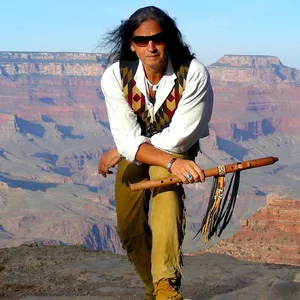
Click Artist Name to see Availble Artwork
Joyce Lee Nevaquaya (1932-1996), was born in 1932 in Apache, Oklahoma, to two Comanche parents, Victoria and Lean Nevaquaya. His parents died when Nevaquaya was only 13, so he lived with his grandparents, who taught him Comanche ways. and he was raised in the Native American Church and attended meetings frequently.
He was named after Dr. Joyce, the doctor who delivered him, and “Doc” became a nickname because of their relationship. Nevaquaya means “well-dressed” in the Comanche language.
Nevaquaya graduated from Fort Sill Indian School in 1951 and took the name Christian name Tate from his grandfather’s business partner as a requirement for enrolling in the school. Later, he attended Haskell Institute in Lawrence, Kansas from 1951 to 1952. There he met his future wife, Charlotte, who was a devout Christian. In 1953, they moved back to Apache where they had five sons and four daughters (Sonny, Jereaux, Sue, Edmond, Joycetta, Timothy, Sonia, Joseph and Calvert) who were all raised under Christian values. He worked many jobs throughout his life and pursued his art on the side. Throughout his life, Nevaquaya worked as a teacher, Methodist lay minister, dancer, composer, singer, historian, painter, and Native American flautist. His devotion to his art greatly influenced the artistic pursuits of his children as well, and his sons have all become accomplished flutist, painters, or dancers.
Although he is well known for his flute playing, Doc considered himself a painter first. He started painting in the 1950s with encouragement from his wife, Charlotte Nevaquaya, who recognized his talent early on. He had no formal training and is considered a self-taught artist. He painted with watercolor, acrylic, tempera, and prints in the Oklahoma Traditional Style with mostly earth tones. He would begin with a sketch that would then be transferred to the board that would be painted on. He was very knowledgeable of Comanche history and culture, and his primary concern was in conveying the beauty of Comanche culture and identity, as well as that of the other tribes he depicted in his art. It is known that he was familiar with other Comanche artists as well, specifically Leonard Riddles (Black Moon Riddles), Bill Poafpybitty, Rance Hood, and Weckeah Bradley, and would invite them over frequently to discuss their art. He sometimes made cartoons as well and knew how to integrate comedy into his work as well.
